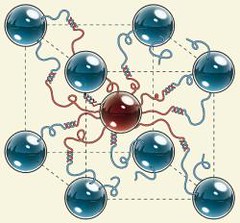
DNA was used to build a three-dimensional structure out of 15 nanometer gold nanoparticles. The gold nanoparticles are the bricks and the DNA is scaffold and mortar. Three-dimensional nanoparticle arrays are likely to be the foundation of future optical and electronic materials.
The novel part of the work is that the researchers use DNA to drive the assembly of the crystal. Changing the DNA strand’s sequence of As, Ts, Gs and Cs changes the blueprint, and thus the shape, of the crystalline structure
“We are now closer to the dream of learning, as nanoscientists, how to break everything down into fundamental building blocks, which for us are nanoparticles, and reassembling them into whatever structure we want that gives us the properties needed for certain applications,” said Chad A. Mirkin, one of the paper’s senior authors and George B. Rathmann Professor of Chemistry in the Weinberg College of Arts and Sciences, professor of medicine and professor of materials science and engineering. In addition to Mirkin, George C. Schatz, Morrison Professor of Chemistry, directed the work.
Giving nanoparticles arms of carefully designed DNA can let them assemble themselves into complex 3D structures (Image: Nature)Using the extremely brilliant X-rays produced by the Advanced Photon Source synchrotron at Argonne National Laboratory in combination with computational simulations, the research team imaged the crystals to determine the exact location of the particles throughout the structure. The final crystals have approximately 1 million nanoparticles.
Mirkin, Schatz and their team just used one building block, gold spheres, but as the method is further developed, a multitude of building blocks of different sizes can be used — with different composition (gold, silver and fluorescent particles, for example) and different shapes (spheres, rods, cubes and triangles). Controlling the distance between the nanoparticles is also key to the structure’s function.
“Once you get good at this you can build anything you want,” said Mirkin, director of Northwestern’s International Institute for Nanotechnology.
Mirkin says that he and his team are just getting started. “To me, it’s really only the start rather than the ending,” he says. Over the past three years, Mirkin’s group has been demonstrating methods to place different DNA linkers on different faces of nonspherical particles, such as triangle-faced prisms and virus particles. That, he says, should enable programming of more complex materials with repeating patterns of three or more components. “The really intriguing possibility here is the ability to program the formation of any structure you want,” says Mirkin.
Stroud says that the structures already produced will be useful as the DNA-programmed assembly is extended to particles other than gold. Applications could include photonic crystals, in which the precise periodicity of particles can tune the overall materials to manipulate specific wavelengths of light, and photovoltaics that capture a broader range of the solar spectrum.The structures are highly porous–10 percent particles and DNA and 90 percent water. That could hinder applications in which water is undesirable. Drain out the water, and the crystals collapse. Gang says that one could stabilize the crystals by filling the lattice with a polymer, but he is also exploring alternate stabilization schemes that would preserve the lattice’s open space.
FURTHER READING
This work is the cover story for the Jan 31, 2008 issue of Nature
New Scientist coverage of DNA construction
The article in nature on DNA assembly of nanoparticles
Chad Mirkin Research group site

Brian Wang is a Futurist Thought Leader and a popular Science blogger with 1 million readers per month. His blog Nextbigfuture.com is ranked #1 Science News Blog. It covers many disruptive technology and trends including Space, Robotics, Artificial Intelligence, Medicine, Anti-aging Biotechnology, and Nanotechnology.
Known for identifying cutting edge technologies, he is currently a Co-Founder of a startup and fundraiser for high potential early-stage companies. He is the Head of Research for Allocations for deep technology investments and an Angel Investor at Space Angels.
A frequent speaker at corporations, he has been a TEDx speaker, a Singularity University speaker and guest at numerous interviews for radio and podcasts. He is open to public speaking and advising engagements.


